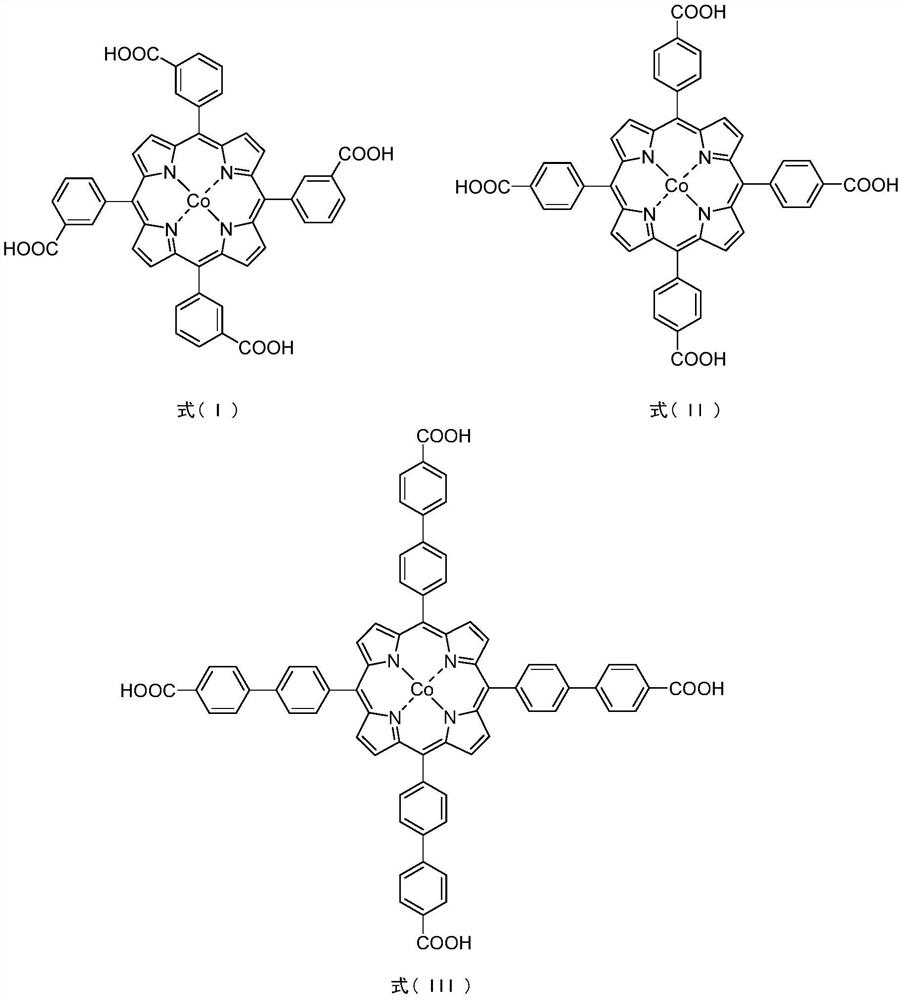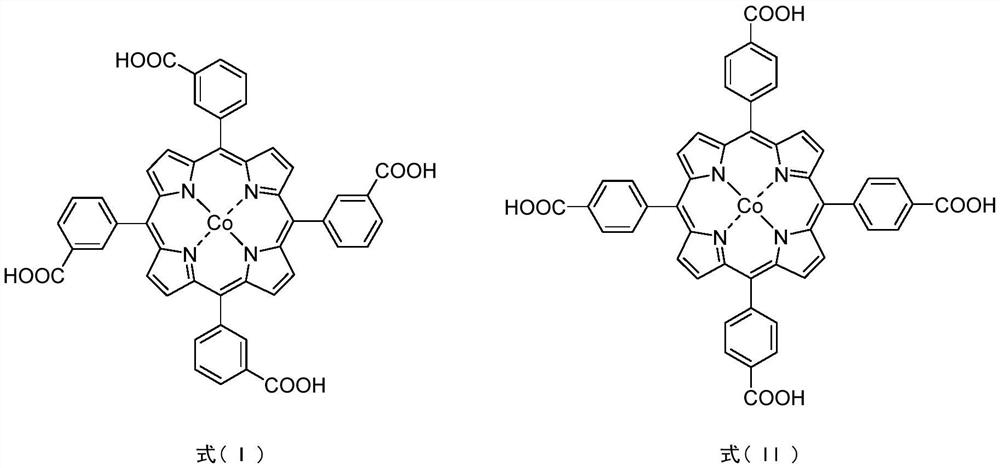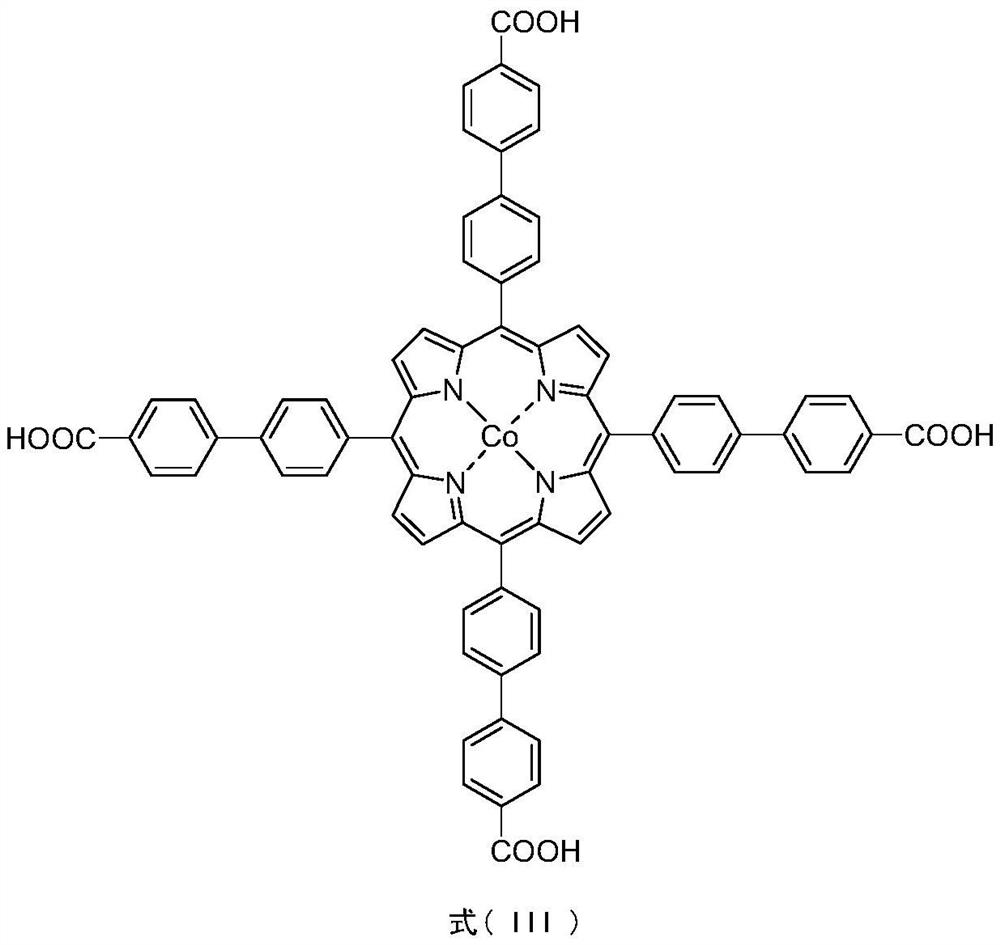Method for synergistic catalytic oxidation of cycloalkane by metalloporphyrin MOFs PCN-222 (Co)/Cu (II) salt
A technology of metalloporphyrin and synergistic catalysis, applied in chemical instruments and methods, physical/chemical process catalysts, organic compounds/hydrides/coordination complex catalysts, etc., can solve the problem of reducing the selection of cycloalkyl alcohols and cycloalkyl ketones Problems such as non-resistance, increasing the uncontrollability of the reaction system, and poor selectivity of the target product can achieve the effects of high selectivity, inhibition of disordered diffusion, and low environmental impact
- Summary
- Abstract
- Description
- Claims
- Application Information
AI Technical Summary
Problems solved by technology
Method used
Image
Examples
Embodiment 1
[0030] Synthesis of PCN-222(Co)-m: In a 35mL pressure-resistant reaction tube, T(3-COOH)PPCo(II) (0.0847g, 0.1mmol), ZrCl 4 (0.1400g, 0.6mmol), benzoic acid (5.4000g, 44.3mmol) was dissolved in 16.0mL DMF, ultrasonic 30min until completely dissolved. The mixture was placed in an electric constant temperature blast drying oven at 120 °C for 48.0 h. After the reaction is complete, turn off the heating, cool to room temperature naturally, filter the crude product with suction and rinse with DMF and acetone successively, then transfer to a 10.0mL centrifuge tube, centrifuge for 5min in a low-speed centrifuge (3000rpm), pour out the upper layer, and dry the DMF Static extraction (3×8.0mL) until the upper layer is clear, dry acetone leaching (3×8.0mL) until the upper layer is clear, remove the solid in the lower layer, and dry at 90°C for 8.0h to obtain a brick red powder (0.0680g, 44.7% yield Rate).
Embodiment 2
[0032] Synthesis of PCN-222(Co)-p: In a 35mL pressure-resistant reaction tube, T(4-COOH)PPCo(II) (0.0847g, 0.1mmol), ZrCl 4(0.1400g, 0.6mmol), benzoic acid (5.4000g, 44.3mmol) was dissolved in 16.0mL DMF, ultrasonic 30min until completely dissolved. The mixture was placed in an electric constant temperature blast drying oven at 120 °C for 48.0 h. After the reaction is complete, turn off the heating, cool to room temperature naturally, filter the crude product with suction and rinse with DMF and acetone successively, then transfer to a 10.0mL centrifuge tube, centrifuge for 5min in a low-speed centrifuge (3000rpm), pour out the upper layer, and dry the DMF Static extraction (3×8.0mL) until the upper layer is clear, dry acetone leaching (3×8.0mL) until the upper layer is clear, remove the solid in the lower layer, and dry at 90°C for 8.0h to obtain a brick red powder (0.0690g, 45.3% yield Rate).
Embodiment 3
[0034] Synthesis of PCN-222(Co)-d: In a 35mL pressure-resistant reaction tube, [T(4-(4-COOH)P)PPCo(II)] (0.1152g, 0.1mmol), ZrCl 4 (0.1400g, 0.6mmol), benzoic acid (5.4000g, 44.3mmol) was dissolved in 16.0 mLDMF, and ultrasonicated for 30min until all dissolved. The mixture was put into an electric constant temperature blast drying oven at 120°C and left to react for 48.0h. After the reaction is complete, turn off the heating, cool to room temperature naturally, filter the crude product with suction and rinse with DMF and acetone successively, then transfer to a 10.0mL centrifuge tube, centrifuge in a low-speed centrifuge for 5min (3000rpm), pour out the upper layer, and dry the DMF Static extraction (3×8.0mL) until the upper layer is clear, dry acetone leaching (3×8.0mL) until the upper layer is clear, remove the solid in the lower layer, and dry at 90°C for 8.0h to obtain a brick red powder (0.0660g, 43.4% yield Rate).
PUM
 Login to View More
Login to View More Abstract
Description
Claims
Application Information
 Login to View More
Login to View More - R&D
- Intellectual Property
- Life Sciences
- Materials
- Tech Scout
- Unparalleled Data Quality
- Higher Quality Content
- 60% Fewer Hallucinations
Browse by: Latest US Patents, China's latest patents, Technical Efficacy Thesaurus, Application Domain, Technology Topic, Popular Technical Reports.
© 2025 PatSnap. All rights reserved.Legal|Privacy policy|Modern Slavery Act Transparency Statement|Sitemap|About US| Contact US: help@patsnap.com



